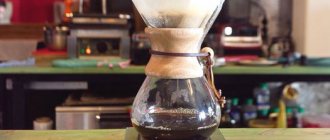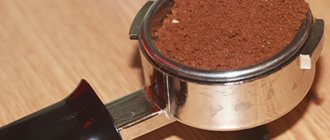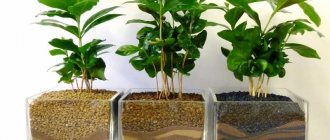What is a coffee siphon
A coffee siphon is one of the devices for making coffee. It consists of two flasks connected by a tube. Water is poured into the first flask and heated (usually with an alcohol burner), a filter is installed in the second flask and ground coffee is poured.
What happens in the siphon?
- When water heats up, it expands.
- The increasing pressure forces hot water into the second reservoir.
- The ground powder is extracted under the influence of hot liquid.
- Gradually, almost the entire volume of water passes through the tube from the heated flask into the flask with coffee, and warm air is displaced along with it. It is this that causes the coffee to bubble in the second part of the device.
- After heating stops, the liquid is poured into the first vessel under the influence of pressure differences and gravitational forces. The filter retains powder particles, and the flask contains the purest, aromatic drink.
What is a siphon (vacuum) coffee maker?
The siphon coffee maker is an intriguing piece that looks like something out of a high school chemistry lab.
You may have noticed this device on the shelves in some trendy coffee shops. Only you probably didn’t know what it was. Now let's figure it out...
A siphon coffee maker is a complete immersion coffee brewing system.
The first chamber of the system uses a heating element to create a vacuum in one chamber. This occurs due to water entering the upper chamber.
Hot water washes over the ground coffee, and the drink then flows into the lower chamber.
History of the coffee siphon
Behind the coffee siphon stretches a rich trail of historical and geographical adventures.
- The device was first invented in the early 19th century. The exact date of invention is unknown, but the first patent was issued in Germany in 1830.
- Several versions of the siphon were proposed by French inventors, so many today believe that the device originated from this country.
- The first siphons consisted of two separate vessels that communicated with each other. The design was very reminiscent of a kind of samovar, especially those versions that were equipped with taps.
- In the mid-forties of the 19th century, the coffee siphon was improved by the Frenchman L. Gabet. He suggested placing the cylinders one on top of the other and taking advantage of the property of water to expand in volume when heated. This principle is still used in siphons today. The proposed design became very popular and is still known in many countries under the name “coffee gabet”.
- The drink in this vessel was prepared in the presence of guests; it was a fashionable entertainment. In France and Germany, many dinner parties in the 19th century ended with siphon coffee.
- Fashion, like fame, passes quickly, so after a while the keen interest in the siphon was lost. Moreover, the device turned out to be quite fragile. Heat-resistant glass was not yet known at that time, and ordinary glass quickly burst from high temperatures and spoiled all the fun.
- For some time, the siphon was subjected to various alterations and improvements, and in the mid-20th century, Asian buyers became interested in it.
- At first, the Japanese used it for its intended purpose and prepared coffee for impressionable visitors to restaurants and cafes, and then adapted it for making tea.
- In this new capacity, the siphon made a return journey to Europe half a century later, simultaneously creating a sensation in America, which was greedy for entertainment.
- The French and Germans quickly remembered that the device was originally intended to be used for coffee ceremonies. The use of heat-resistant glass in production eliminated previous inconveniences, and the siphon took its rightful place in coffee shops and on kitchen shelves. In 1985, the first European industrial production of this device opened in Holland.
- Today it is used mainly in bars and coffee shops; not so long ago, the device “showed up” at barista championships. Coffee from a siphon turns out tasty and aromatic, so the growing popularity of the device does not surprise gourmets.
A little history
A patent for it was issued in Berlin in 1830, but at the same time the French offered a number of their own versions of the siphon. The name, by the way, comes from the surname of the Frenchman Louis Gabet.
In subsequent years, the device was repeatedly improved. For example, the Japanese used this device in making tea.
Invention of the balancing siphon
The process of brewing coffee in a Vassier siphon looked very impressive, and therefore soon such devices began to be placed on the table. But it turned out that the lower ball was too fragile: as soon as the housewife was careless and did not turn off the burner in time, the glass would burst or even explode. Heat-resistant glass had not yet been invented at that time.
It was urgently necessary to come up with a way to automatically turn off the burner. The best design was patented in 1844 by the Frenchman Louis Gabet. His coffee siphon consisted of two communicating vessels: ceramic and glass, mounted on a balancer lever (Fig. 2). They were connected to each other by a tube.
“Second life” of the coffee siphon
Coffee siphons were quite popular at the beginning of the 20th century. In the USA, they invented and patented a mechanism that turns off the alcohol burner in coffee pots, similar to Madame Vassier’s siphon. Coffee makers of this design were produced by the American company Silex.
With the invention of fire-resistant glass, many countries began to produce not only balance siphons, but also vertical siphons, which also began to be called gabettes. These gabets differed from their predecessors in the 19th century only in their greater strength and the presence of a seal between the upper and lower vessels. Over time, the alcohol burner was replaced by an electric heater. In the USSR, vertical electrogabetes were manufactured back in the 50–60s of the 20th century (Fig. 4).
Soviet electric gabet of the mid-20th century
But due to the popularity of instant coffee, gabets gradually went out of use. Then humanity became interested in espresso, and only at the beginning of the 21st century, when alternative methods of brewing coffee came into fashion, did they remember about gabets again.
Now balanced and vertical siphons for making coffee are produced by the companies Hario, Cona, Bodum, Yama. There are also souvenir models with alcohol burners and vertical siphons with gas burners on sale (Fig. 5). Vertical gabits with infrared heaters look very impressive (Fig. 6).
Vertical gabet with gas burner
Gabet with infrared heating element
Basic rules for using a siphon
I can’t help but mention some rules for the safe use of a siphon:
- Jigger - types, shapes, styles, measurements and rules of use. 120 photos of jiggers for strong alcohol
Whisk: models, designs, tips for use and features of choosing a whisk (135 photos and videos)
Zest knife - description of a quality tool, use of equipment and use of zest (85 photos and videos)
- Use grips or gloves when handling hot parts of the siphon
- Use a special gabet stand
- Use the device again only when it has cooled down
- If there are children in the house, it is better to keep your siphon away from them.
Features of operation
When preparing tea or coffee in a siphon, it is worth keeping in mind some features of the operation of this device.
- A high-quality and reliable siphon allows you to prepare any types of tea and coffee. As mentioned above, with the help of such a device there is an excellent opportunity to make entire cocktails from the mentioned drinks. These treats are made from a combination of different ingredients.
- The main advantage of preparing tea in a siphon before brewing coffee remains the constant spectacle of the process itself. Coffee itself is a fairly thick, impenetrable drink. In the siphon, it does not attract attention to itself. With tea, everything is different - it actively bubbles, moving from one flask to another. This process is necessary. There is no need to stop it.
It should be taken into account that it is not necessary to remove it from the infuser compartment after preparing tea and throw it away. It’s better to make another portion of this aromatic drink from this brew.
- When working with such a device, it is very important to follow safety rules - this is one of the main features of using the gadget. Otherwise there could be very bad consequences.
- When preparing aromatic coffee, you need to take into account that the finer the grind, the fewer minutes it will take to extract the treat. Therefore, when using medium-fraction powder, the fire in the burner will need to be reduced a little, allowing the coffee in the container on top to brew for another minute. In this case, the water will be even better saturated with taste and aroma.
To brew delicious drinks, it is recommended to use hot water, but not boiling water. This way the coffee or tea is prepared a little faster. Although true gourmets still prefer to prepare such drinks using only cold liquid.
How to use a sparkling water siphon?
In order to learn how to work with a siphon, it is enough to prepare a drink in it once:
- Water is poured into the siphon.
- The nozzle is screwed on top.
- A can of carbon dioxide is inserted into the clamp socket and screwed into it.
- A hollow needle in the body of the clamp pierces the cap of the can.
- Carbon dioxide enters the siphon under pressure, saturating the water.
- When you press the tap lever, water is displaced by gas pressure, rises through the tube and pours out through the drain pipe.
- During operation, it is necessary to monitor the cleanliness of the internal and external surfaces of the device, as well as the integrity and cleanliness of the rubber seals in the nozzle.
Rules of circulation
Operating a coffee siphon is quite simple, but you still need to know some operating rules.
- The heating element does not cool down immediately, so it should be handled with care using oven mitts.
- It is not recommended to expose the siphon to constant heating for more than a certain time. Exposure to the flame should last for 10-15 minutes, then the device should be allowed to cool completely before using it again.
- The alcohol lamp or burner should be refilled with fuel in a ventilated area.
- Get a special stand for manipulating the siphon, preferably made of non-flammable material.
Why do we need a siphon today?
Indeed, in our age, with the availability of various modern types of coffee machines, why such an outdated, unsightly-looking device?
It's very simple: the incredible flavor bouquet in a small cup of coffee justifies all the costs. It’s not for nothing that baristas often use it in their competitions. Who else but them knows a lot about real coffee?
Design
To quickly understand how such a useful and functional device works, you need to familiarize yourself with its design. I must say that it is not the most difficult. Of course, over time it was seriously modernized, but its main “units” still remained the same. A siphon for tea and coffee consists of such elements.
- The glass flask at the bottom. This vessel is usually round or teardrop-shaped. It is made from a reliable heat-resistant material that is not afraid of high liquid temperatures.
- Metal tripod. The lower vessel is attached to it so that there is free space for the heating element to be located.
- Upper flask. This component is usually made of glass. Most often it has a cylindrical shape, a little less often - spherical. In the lower part, the indicated container is complemented by a fairly long tube. Once the device is assembled, it will need to reach the very bottom of the bottom heat-resistant container.
- The device also has a lid.
- Rubber seal located between the flasks.
- Filter with small cells. It is usually located on the top tank. It is made either from metal or fabric.
- Heating source. Basically, this function is performed by a simple alcohol burner. But modern experienced baristas more often use specialized models with a gas burner. They are often an integral component of the kit of some models of modern siphons. The main advantage of such devices is that with them it is possible to more accurately regulate the heating under different drink preparation modes.
Principle of operation
From the above information we can conclude that the device of the gadget is quite simple and understandable. Knowing it, it is easier to understand what the operating principle of the device is. Let's take a closer look at how such a device works using the example of a tea siphon.
First of all, before starting to operate this device, you always need to check the reliability of its design. The filter must be firmly attached to the upper container using a spring. The latter, in a state of tension, is fixed using a special hook that follows from the edge of the connecting tube.
Such a device operates on the principle of gas expansion under heating conditions. Pour hot water into one of the containers. As for the second one, which connects to the first special glass tube, you need to pour tea leaves into it. The liquid in the container located below heats up and bubbles, gradually rising to the container located above. Boiling (not to be confused with boiling) allows the liquid to achieve sufficient oxygen saturation, which has a beneficial effect on the taste and aroma of the drink. Everything usually takes about 30 seconds or 1 minute. By changing the power of the burner, it becomes possible to regulate the force of seething.
A drink, for example tea, can be stirred gently using a wooden stick. To do this, just remove the cap. As soon as the tea is ready, the burner must be turned off and put back in its place. Remove the plastic cap from the flask on top. The drink descends accompanied by a characteristic fizzing sound.
After all the above steps, it is permissible to proceed to disassembling the device. Flasks must be removed only while wearing gloves. The container is removed from the top and carefully placed on the inverted lid.
It is not recommended to throw away the tea leaves. It is better to brew it again. From the container located below, tea will need to be poured into bowls or poured into an intermediate teapot. This way you can cool the drink and let it stir well. The complete cooking process rarely takes more than 10 minutes.
What is the advantage of a vacuum (siphon) coffee maker
The beauty of the siphon method comes from 4 main elements.
Full immersion
You may know that full immersion means that the ground coffee and water are in contact throughout the entire brewing process. Similarly, coffee is prepared in an AeroPress and a French Press.
Full immersion brewing typically produces a light, clean-tasting coffee.
Vacuum
After the ground coffee sits in the hot water for a while, a vacuum created in the lower chamber draws the coffee-rich liquid down through the filter. Thanks to this technique, all the oils (and therefore the taste) of the coffee are captured.
The result is a cup of coffee with a stunningly pure aroma. It will contain all the nuances of flavor from your favorite grind.
Sequential heating
Many coffee brewing methods require the use of preheated water that is poured into the ground coffee. In a siphon coffee maker, water is heated gradually.
As you know, temperature is an important factor affecting the quality of the final drink. If the heating is gradual, you can better control the quality and taste of your coffee.
Aesthetic and intriguing appearance
Strictly speaking, the appearance of the device will not affect the result in any way. Still, it is worth admitting that the siphon standing in your kitchen will definitely impress your guests.
Siphon, Hario NXA-5
(link to lot)
Arrived in a box with the symbols of the Japanese division of Amazon. As it later turned out, the seller works as an intermediary between Amazon Japan and Western buyers.
With a smiley face on one side...
... and a sizable hole on the other
Since nothing was clinking or spilling inside, I didn’t open it at the post office, deciding that, as a last resort, a dispute in a stick would put everything in its place. Let's open it further: a box with a siphon in a bubble wrap and a couple of wads of wrapping paper.
Front view box.
Box in profile and from other sides
Open the box. Please note that, according to Japanese canons, the lid opens from left to right.
We exhale, the flasks are intact. Let's look further.
The box contains: - the siphon itself, consisting of two glass flasks, a lid and a stand; - alcohol burner; — fabric filter; - metal filter; - measuring spoon; - manual. Let's start with the manual and small things.
Manual
Quite a voluminous document in several languages. The main characteristics of the siphon, methods of use and maintenance, as well as safety precautions are listed.
Other pages
Measuring spoon
Made of plastic, quite durable and voluminous.
I don’t use it for its intended purpose, because... I use a coffee grinder to measure the required amount of coffee, and it’s more convenient to stir the coffee while brewing with a regular teaspoon. There was also no use for it in everyday life, so it lies idle in a drawer.
Filters
The set includes two filters: with a fabric filter element and with a steel mesh
Both filters have their advantages and disadvantages.
For a cloth filter: + Complete filtration of even the smallest particles of ground coffee - Retains aromatic oils - Requires careful handling (the instructions recommend storing the filter element in the refrigerator in a container with water) ± Sooner or later it will wear out/contaminate and require replacement
For a metal filter: + Does not retain aromatic oils + Does not require special care + Almost eternal (can, of course, be broken, but only on purpose) - Allows small particles of ground coffee to pass through
Due to the above, the fabric filter was not intended to be used initially, so there will be detailed photos of only the metal filter.
The filter consists of a base, a filter mesh and a silicone ring. The base is flat, made of fairly thick stainless steel. A chain with a spring and a hook is attached to the base, with the help of which the filter is secured in the upper flask.
The mesh is semicircular with a flat flange and small holes. The holes appear to have been made with a laser.
The silicone ring holds the base and mesh together and seals where the filter meets the flask.
Alcohol burner
Since it was not planned to use the burner, I did not unpack it and the photos will only be taken from the packaging.
It looks like an ordinary alcohol lamp: a plastic stand, a glass flask, a wick, a flame-extinguishing cap. Additionally, there is something like a windproof “collar”
Siphon
Actually, the main character of the review is in full growth
The height of the assembled siphon is approximately 38 centimeters. Now let's break it down into its component parts.
Stand
The stand is all metal, probably stainless steel. A rubber-like coating is applied to the vertical part, very similar to a soft touch, quite thick, you can press it with your fingers a few millimeters. On the top of the stand there is a clamp for the flask.
The design is very simple: two jaws are connected by an axis passing through the stand rod. The nut, moving along the rod, tightens or releases the jaws. Rubber pads are installed on the inside of the jaws to prevent damage to the flask.
Flasks
Bottom flask.
The flask is marked with volume markings and safety warnings.
It is very difficult to photograph a transparent object that was out of focus, so I had to heavily edit the photo to make the inscriptions visible.
Upper flask and lid.
The lid performs both the function of the lid itself and the function of supplying the upper flask. The flask seal is made of silicone and cannot be removed from the “trunk”.
A little about the sad
As you can see, the main material of the siphon is glass, and glass is fragile, even if it is at least three times tempered. In general, it turned out that after six months of use, the upper flask died the death of the “brave but fragile.” By this time, I was already accustomed to the fact that the flask tolerates light impacts on the sink during washing (and with a small sink this is almost inevitable, since the flask is quite large). Therefore, another light blow with the end of the “trunk” on the sink did not alert me at all, if not for the unpleasant crunch of pieces of broken glass rubbing against each other. Later, in hindsight, I realized that just such a blow is the most dangerous for this flask design.
Subtleties of cooking
Coffee siphons can be of different volumes - from 300 to 1500 ml. The most common options are 450-600 ml. Regardless of size, there are some cooking considerations you should be aware of if you want to use your siphon at its best.
- Water should not be poured into the lower flask to the top, but to a special mark.
- The brewing process produces a rich and strong drink; 2 heaped teaspoons of coffee for every 100 ml of water is enough.
- It is recommended to take water for brewing that has already been heated, but not boiled. This reduces the preparation time of the drink. However, gourmets still adhere to the tradition of preparing coffee with cold water.
- You can choose the coffee grind according to your taste. Grinding is good for Turkish grinding. It brews quickly and gives off good taste and aroma.
- The finer the grind, the less time it takes to extract the drink. Therefore, after choosing a medium-fraction coffee powder, reduce the heat on the burner and let the coffee brew in the upper tank for an additional minute. Then the water will be better saturated with aromatic and flavor fractions.
- Serve and pour coffee into cups as quickly as possible. The thin glass container cools quickly and the drink loses its taste.
- If you are determined to constantly prepare coffee in a siphon, then purchase a special gas burner for it, maybe even a tourist one. It is much better regulated and provides any heating intensity.
The water in the siphon does not boil, as in a kettle, it is close to a boiling state, which in the East is called “white boiling water”. At this moment, the liquid is maximally saturated with oxygen. Perhaps this is why the drink from the siphon has an excellent taste.
Advantages and disadvantages
Let's summarize and describe the pros and cons of the Gabeta siphon for coffee. Let's start with the positive points:
- Siphon coffee has its own unique taste and is definitely worth trying.
- If you choose one of the retro variations of siphons, you have the opportunity to enjoy a unique spectacle, the process of preparing this ancient drink from the gabeta siphon.
- You can make not only coffee, but also excellent tea. You can't do this in a regular coffee machine.
Minuses:
- the price for branded devices is quite high
- Siphon flasks are quite fragile and need to be handled with care.
How to make coffee in a siphon
At first glance, it is completely unclear how our favorite aromatic drink is prepared in this transparent device. But after a couple of uses, you will be convinced that making coffee in this way is a completely hassle-free task.
So, how to make coffee in a siphon?
There are two popular methods.
1 way
- Pour water into the bottom flask up to the mark.
- Install the top part.
- We install a filter in the upper flask; it is advisable to pour boiling water over it before doing this.
- Place ground coffee in the second flask. It will be placed directly on the filter, don’t let this bother you. Close the lid.
- We light the heating element.
- We wait.
- When heated, the water passes through the tube into the upper reservoir and begins to bubble in it.
- After waiting a minute or two, remove the heating element.
- The coffee is lowered through the tube into the lower flask. It is this moment that gives the spectacle of making coffee in a siphon.
- Remove the top part, remove the bottom part and pour the drink into cups.
Method 2
- Pour water into the bottom flask.
- Install the upper part of the device and remove the cover.
- We place the ignition element and wait for the moment when most of the liquid is forced into the upper reservoir.
- After this, pour coffee powder into the boiling water and stir with a long spoon or wooden stick.
- Let the infusion bubble for another minute and remove the heating element.
- The coffee flows into the lower reservoir.
- Remove the top, carefully remove the bottom flask from the mount, and pour the drink.
History of Gabet
In Western Europe, unlike Eastern Europe, love with a Turkish woman did not work out. From the 18th to the 19th centuries, European coffee lovers tried to come up with a device that would allow them to prepare aromatic and tasty coffee.
In the 30s of the 19th century, coffee makers, consisting of two spherical vessels connected by a tube, came into fashion. Water was poured into the lower container, a filter was placed at the bottom of the upper container and coffee was poured. The lower container was heated. When the water boiled and steam formed, under the pressure of which it was forced out of the lower vessel into the upper one, where the coffee was brewed.
After this, heating was stopped. As a result, a vacuum was created in the lower vessel, due to which the finished coffee from the upper container was sucked into the tube and flowed down. The lower vessel was equipped with a tap, with which it was easy to pour coffee into cups.
It is believed that the first person to come up with such a design was the Berlin inventor Loeff. History has not brought us images of the coffee maker he created. But in 1841, a certain Madame Vassier from Lyon patented a device that differs from modern siphon models only in the decorative crown crowning the upper ball (Fig. 1).
Fig.1. Coffee maker patented by Madame Vassier
The coffee in the siphon turned out excellent: aromatic and not overcooked, since the ground beans were in contact with hot water and not boiling water. Initially, candles and oil lamps were used to heat the lower ball, but it turned out that the best option was an alcohol burner.
Where and at what price to buy a siphon
Like other devices for brewing coffee, a siphon (or gabette) is easy to find in specialized coffee accessories stores or on the Internet. The well-known company from Japan Hario offers a wide range of such devices.
Most models are small in size for the convenience of private users. The 300 and 400 ml siphons are ideal for preparing two cups of coffee. You can find affordable models of this format for about 3 thousand rubles.
And the most advanced models of the new generation from Hario are noticeably more expensive. For example, such 600 ml devices are sold at a price ranging from 9 to 15 thousand rubles. Those who don’t want to bother with burners can purchase an electric gabet model with a capacity of 360-400 ml for about 6-7 thousand rubles. Original and picturesque models in retro style for 350-400 ml are sold for 7-9 thousand rubles.
A standard siphon, recommended for home use, with a 400 ml tank sells on average for 3-4 thousand rubles.
Safety regulations
When using a siphon, you must adhere to the following safety rules:
- Do not touch glass tanks with bare hands. You need to use fabric gloves or oven mitts;
- Durable glass is used to make the flasks, but the risk that it will break still remains . Therefore, tanks must be handled with care;
- The burner should be refueled away from fire sources and heating devices. Perform these steps only after the heating element has completely cooled down;
- It is strictly prohibited to heat the gabette for more than ten minutes. The lower reservoir may burst.
Please note before purchasing...
So, you have read the reviews of the best siphon coffee makers available in the market. Let's see what other useful things you need to know about the device and the process itself.
Is the coffee maker freestanding or stovetop?
Siphons can be used both autonomously and on a stove. The quality of the coffee does not depend on this.
A stand-alone siphon coffee maker prepares coffee using a built-in or separate burner, which is located under the lower chamber. The burner can be either alcohol or gas.
There is another type of siphon coffee makers that operate on an electric or gas stove. Keep in mind that you will need to place a diffuser between the device and the heating element. Direct contact with heat can increase the likelihood that cracks will develop in the lower chamber.
We prefer freestanding siphons that look vintage and meticulously detailed. True, such devices are slightly more expensive than simpler models that work on the stove.
Materials
Preparing coffee using the siphon method has been used since the 1830s. At that time, devices were made of brass and stainless steel. Such models can still be found. True, now they will rather play the role of decor, paying tribute to the old times. Such devices are unlikely to be practical.
Nowadays, the bodies of the best, high-quality siphons are made of heat-resistant borosilicate glass. This, of course, does not mean that the devices become indestructible. If you take care of them carefully, they will last you a very long time.
Filters
Most siphon coffee makers use fabric filters, which are great for sifting out coffee particles. However, such filters are difficult to clean. If you don't want to bother, choose a model with a stainless steel filter. Cleaning these filters is very simple.
What about burners?
If you decide to purchase a stand-alone coffee maker, then it should come with a burner. Different burners are combined with different models of siphons.
The most commonly used burners are butane, gas and alcohol burners. Newer machines may use electric or halogen burners.
The alcohol burner is the cheapest. However, you may find it difficult to control the temperature until you get the hang of it. You may also find that there will be a lot of soot left at the bottom of the siphon.
We prefer gas or butane torches. They are usually quite reliable. They are easier to use and control than alcohol burners and will not leave soot marks.
How many servings of coffee do you want to make?
Like many other systems, siphons can produce different amounts of coffee. Usually you can prepare from 3 to 8 mugs at a time. Don't forget to check the coffee maker's capacity before purchasing to make sure it suits your coffee consumption level.
Where to buy this device
New or used models of specialized bar equipment, including siphons, can be easily found in numerous online stores. It is also not difficult to purchase household models of such devices via the Internet on Aliexpress, and on eBay, if you are lucky, you can even find stylish vintage copies.
In the retail sale of household goods, some siphon models are distributed through chain hypermarkets, for example, Auchan or Mediamarkt.











